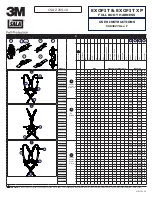
Configuration and Installation
Section Three
GPIB-1014P User Manual
3-10
© National Instruments Corporation
Table 3-1. GPIB-1014P Pin Assignment on VMEbus Connector P1 (continued)
Pin No.
Signal Used
Signal Not Used
Pin No.
Signal Used
Signal Not Used
C1
D08
C17
A21
C2
D09
C18
A20
C3
D10
C19
A19
C4
D11
C20
A18
C5
D12
C21
A17
C6
D13
C22
A16
C7
D14
C23
A15
C8
D15
C24
A14
C9
GND
C25
A13
C10
SYSFAIL*
C26
A12
C11
BERR*
C27
A11
C12
SYSRESET*
C28
A10
C13
LWORD*
C29
A09
C14
AM5
C30
A08
C15
A23
C31
+12V
C16
A22
C32
+5V
Verification Testing
A verification test can be run to ensure that the board has not been damaged during shipment and
also to ensure that the board has been configured correctly. This requires an interactive control
program or an equivalent mechanism, such as front panel control switches or front panel emulator,
that provides a way to load and read memory and I/O addresses.
The tests presented in Section Seven of this manual consist of a series of steps written in a pseudo
(processor-independent) language with instructions. The steps generally involve writing data to
specific GPIB-1014P device registers followed by reading other GPIB-1014P registers to verify
that the programming is correct. These tests exercise virtually all of the major functions of the
GPIB-1014P, including I/O communications and GPIB communications. All functions except
GPIB communications can be performed as stand-alone operations (that is, without another GPIB
device). To completely check the GPIB functions, you must use a bus tester or analyzer (such as
National Instruments GPIB-400 or GPIB-410) that can monitor and control GPIB signal lines;
emulate GPIB Talker, Listener, and Controller devices; and single-step through the Source and
Acceptor Handshakes.
Cabling
Optional cables are available to connect the GPIB-1014P to other GPIB devices. Connect the cable
to the GPIB-1014P at the standard GPIB connector labeled
J1
at the top of the interface board.
(The GPIB connector protrudes through the metal front cover plate.)
















































